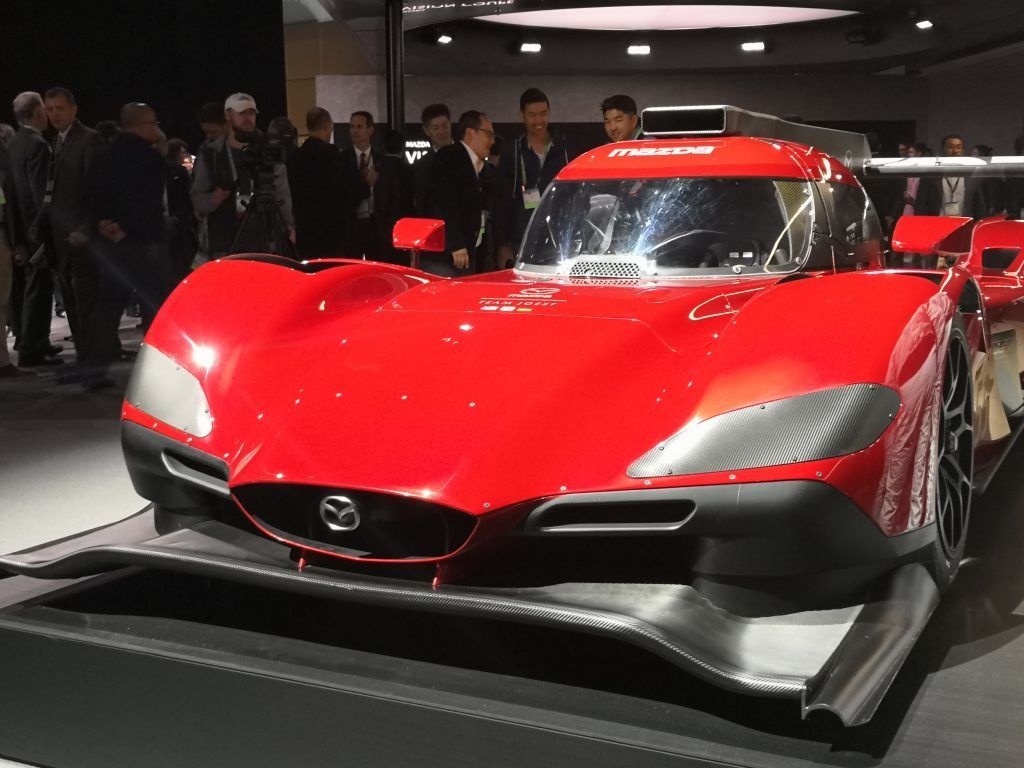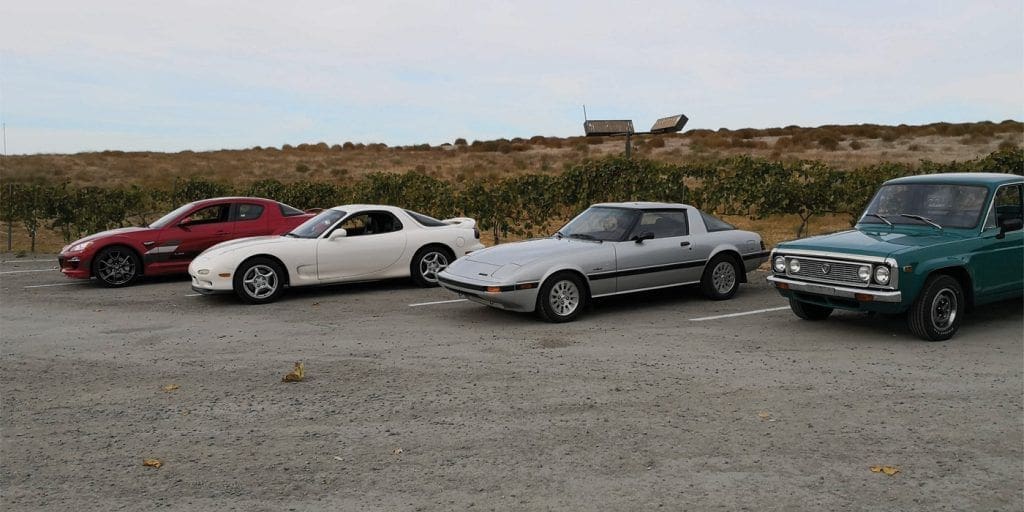Mazda’s Delicious Doritos
Pardon the pun but the ICE (internal combustion engine) has been getting quite the cold shoulder recently. Piston power and fossil fuel are being cast aside in favour of battery cells topped up by sunny days, flowing streams and wind chimes. Right now, it seems like the automotive world is on a quest for alternative power-trains, but as history would attest, that has always been the case.
Since the clippity-clop of horses changed to steam and then pistons, the search for alternatives has been strong, and the results have been varied. Electric vehicles (around since 1832), hybrids, the opposed-piston/opposed-cylinder (OPOC), Stirling engines, Scuderi, the free piston… all have been under the hood at least once. But the one I want to talk about here is the rotary.
It’s pertinent to note that no other car company has lovingly embraced or invested as much in the rotary power source than Mazda. With that in mind, Mazda New Zealand invited us to Orange County, California, to help celebrate the half-century of the Wankel. It would be a fun-filled trip that included iconic Mazdas, a wonderfully historic drive through the canyons and some Doritos – all very tasty indeed.

German mechanical engineer Felix Wankel completed the first running prototype of the rotary engine in 1957 and he creatively named it the Wankel. It is simple, smooth, compact, revs high and has a very high power-to-weight ratio, basically, all the things you look for in an engine. Ten years later, in 1967 (which is coincidentally around the same time that Doritos were launched nationally in the United States), Mazda, looking to distinguish itself from other Japanese car manufacturers, began its 50-year (so far) relationship with the rotary. Trust me, the corn chip association is relevant.

Mazda’s first rotary-powered vehicle was the Cosmo Sport 110S. It’s a glorious looking, rear-wheel-drive sports car that made jaws drop (it continues to do so) when it made its debut in 1967. Since then, Mazda has used this powertrain in its sports coupes and Le Mans-winning vehicles, and gained many ardent fans along the way. But I’m getting ahead of myself.

Alright, so, when you get down to it, the Wankel rotary is an ICE. However, rather than having reciprocating pistons, the four-stage cycle of intake, compression, ignition and exhaust occur each revolution at each of the three reuleaux triangle-shaped rotor tips, as they move inside the oval-like epitrochoid-shaped housing. This enables three power pulses per rotor revolution. Or, in more layman’s terms (actually an easier way for me to understand), the rotor (which is similar in shape to a Dorito) spins around very quickly inside a rugby ball-shaped cylinder, creating enough pressure to make a car go fast – told you the Dorito would all make sense.
Our celebration commenced on a west coast beach, Laguna Beach, to be exact. Although this area dates back to the Paleoindian times, much like the Rotary engine, Laguna Beach (which I found to my disappointment is nowhere near the Mazda Raceway Laguna Seca track) is also a child star of the 60s. It was the epicentre of the ‘alternative’ hippy culture and where the Brotherhood of Eternal Love was located – but we won’t go into that now.

We stayed at the most amazing Montage Laguna Beach. It’s a mixture of ultra-modern facilities and classic old Hollywood style, and all with an artistic theme befitting the area. Seriously, even the design on the bottom of the pool conjures up images of synchronised swimmers in big production movies of the roaring ’20s. We ‘climatised’ very quickly.
Next morning we took to the Californian freeway in two of Mazda’s latest offerings: an MX-5 RF and a CX-5, both left-hookers. The 30-minute drive to Irvine, where Mazda North American Operations (MNAO) and HQ are located, gave us time to become more au fait with driving on the wrong side of both the car and road, and question why they haven’t changed over – sigh.
Having moved ‘straight outta Compton’ in 1987, MNAO has claimed Irvine as its home, with addresses at 7755 Irvine Centre and their recent move (expansion) to 200 Spectrum Centre. Knowing full well what lay ahead of us, we arrived at the Irvine Centre with our cameras at the ready.
The facility itself is on the LAX flight path (so no drones in sight), and was once the home of Taco Bell (there’s that food association again). But we were not there for a tour of the whole complex, only it’s basement, as that’s where they store the treasure.
As the roller door retracted and the fluorescent lights flickered on, I felt a bit like Indiana Jones (but without the fiery torch). A seemingly endless stretch of Mazda’s finest, all in their assigned parking lot bays, it was quite a ‘wow’ moment.

Historical figures, racing champions and even a TV celebrity were ready for introductions. A 1973 RX-2; an RX-7 Daytona; an MX-6 GTO; the five-time winner 1991 RX-7 GTO; the ’86 Racing Beats RX-7; a 200mph 1990 787 that finished 8th at Le Mans; an RX-792P; a 1992 MX-R01; a Miata (MX-5) Speedster; an RX-8; a Super 25; a Super 20, as seen on the Grand Tour; and the Taiki concept car from 2007.
The list was as expansive as the garage and the treats were mouthwatering. I was allowed to squeeze (quite literally) my sizable rump into the 767B Le Mans car and the Cosmo Sport – priceless. I didn’t do a tally (actually I had no idea what should be there), but apparently four were missing and we were about to find out why.

First of all, though, we stumbled upon Wolverine’s RX-8 in among several less-than-loved vehicles. For a number of, let’s say, clerical reasons, this movie star of a vehicle has yet to find a home, so it remains left out in the cold… OK, basking in the Californian sun, but I think you get the point – I did offer to bring it back to NZ, but unfortunately I got nowhere.

This brings me to the last (missing) four rotarys. A 1975 Repu rotary truck with a racing exhaust and a five-speed manual gearbox from an RX-7; a 1985 RX-7 GSL-SE with around 1500 miles on it; a 1995 RX-7 FD with 26,000 miles on it; and the last rotary ever made, the 2011 RX-8 with LM20 sticker package, and, get this, only 89 miles on it. The good news was that we were going to have the pleasure of driving each and every one of them; the even better news was the road we would be driving them on: the Ortega Highway.

The Ortega Highway/Route 74 is a winding noodle of tarmac that weaves its way through the Santa Ana mountain range alongside steep canyon drops. It’s the western part of the Palms to Pines Highway, it’s notoriously dangerous due to its gradients and sharp corners, and it’s allegedly haunted. So, perfectly fitting for the cars Mazda had laid on. Time for a little clowning around (that joke makes sense when you Google the road (plus clown) later).

I immediately went for the ’85 RX-7. It had been a very long time since I’d been behind the wheel of a first-generation RX-7 and the memories came flooding back. It’s a sports car through and through. A small and compact two-seater, long nose, no power steering and an excellent driving position. This example drove like new; the gearbox offered no play and it handled the bends tremendously. The sound of the rotary echoed around the canyon and when the sign prompted us to put on the headlights, up they popped, which caused me to let out another happy sigh. I’m a big fan of the pop-ups, and the 80’s, for that matter.
We stopped at the Ortega Oaks Candy Store, but no candy was purchased (our rides were sweet enough). Vehicle change… I opted for the Repu. A big heavy old truck to roll down the other side of the Santa Anas, what could possibly go wrong? Well, ‘brakes’ is the answer to that question. It would appear (to my glee) that the old drum brakes aren’t as effective as they could be, when going down steep gradients and hairpin turns, preferring to glow as red as a clown’s nose, and smoke – a lot.

Safely back on the flat, (another sigh, but this one with some divine thanks attached), we let the Repu’s rotary engine/sports exhaust combo run amok. Racing (ahem) from stop sign to stop sign and revving way up high – just what a rotary was built to do. It was an aural delight.
The late lunch was held at Callaway Vineyard & Winery – tasty but brief, after all, there were two more Mazdas to experience. It was going to be mainly a freeway drive back to the HQ, so I moved to the RX-8. The 36-year difference between the two vehicles was certainly noticeable. The RX-8 is quite a refined drive, the rear suicide doors are cool and the rotary goes about its business very quietly (or maybe my ears were still ringing from the Repu). One last stop and a change to the FD. Far sportier than the ‘8’ and a little more involving, unfortunately not too much to do on the Californian highways than speed up and slow down, it was still fun though.
With our tour and drive over, we said goodbye to our nostalgic rides and headed to the bright lights of LA. Not only to come right back to the present, but also to see a bit of the future – we had press passes to the LA Auto Show.
We stayed at the Intercontinental in downtown LA… sounds cool when I say it like that (it’s even cooler staying there). At 73 stories high and 1100 feet above street level, it’s the tallest structure west of the Sears in Chicago and its ‘Spire 73’ is the tallest open-air bar in the western hemisphere. The Intercontinental is a place that overlooks the city, the Hollywood sign and, well, basically everything else out there.
We headed to the show early next day and had our fill of the other car makers’ visions of the future (many of them embracing EVs) before returning to the Mazda stand and witnessing theirs. The Vision Coupe, (elegant art on wheels), the Mazda6 (a refined executive) and the (ICE breaker) SKYACTIV-X powertrain – what a way to end the celebration.

It’s easy to see (and hear) why Mazda has had such a love affair with the rotary. It’s such a playful powertrain that allows you to explore ‘near-motorbike high’ revs and extract ludicrous amounts of power from such a compact motor. Maybe its future lies in supplying extra force or range to battery power; or maybe the boffins at Mazda will find new ways to make them compete in this environmentally conscious and ultra-efficient world we’re leaning towards (the SKYACTIV-X proves they can modernise the reciprocating piston), who knows?

But, after my amazing Californian experience, what I do know for sure is, for the past 50 years, Mazda has been creating some outstanding vehicles that have captured hearts, dropped jaws and won trophies; and they have all been snacking on that little rotary spinning Dorito. Now, ain’t that something delicious.

